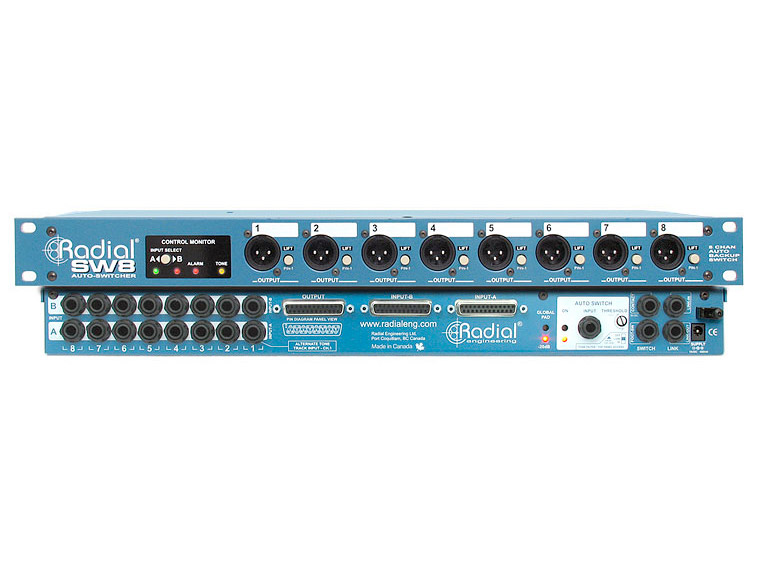Radial SW8 Auto Switcher
The Radial SW8 is an 8 channel auto-switcher that allows you to set up a redundant backup system by automatically switching between two sources such as a pair of digital recorders, computers or network systems.
Designed primarily for live concerts and stage shows where backing tracks are used for orchestration, vocals and sound effects, SW8 employs an adjustable gate to detect a machine malfunction and automatically switch to a second ‘backup’ machine to deliver a seamless performance. One merely records a steady state signal on a track and feeds it to the SW8. Should the signal drop, the SW8 will automatically switch to the B system and ‘sound’ an alarm. Switching can also be performed manually via the front panel A~B switch, a rear access latching switch or by using the optional Radial JR2 footswitch. For larger systems, multiple SW8s may be linked together to create 16, 24 or 32 track systems.
Housed in a heavy duty 14-gauge steel 19″ enclosure, the Radial SW8 is equipped with choice of 25-pin D-sub or ¼” TRS connector inputs with both XLR and D-Sub outputs. The front panel XLRs produce a balanced DI mic level to feed a snake system and are transformer isolated to eliminate hum and buzz caused by ground loops. The rear panel D-Sub provides direct balanced line level connectivity and the transformer isolated outputs may be internally re-patched to send the mic level signal to the 25 pin D-sub output if needed. To further suppress switching noise, a series of internal filters help eliminate DC offset from offending source devices. A global mute switch may be engaged that turns off the XLR outs, enabling you to audition and cue tracks on the fly. This is augmented by a standby switch that holds the SW8 on the source-A inputs in between songs.
The Radial SW8 eliminates embarrassing system malfunctions by providing an easy to implement system that will ensure your show will go on!
The following are three common scenarios used today in live production. For obvious reasons, we have removed the names of the bands and technicians who provided this info as many artists like to keep their production secrets, well… secret! Each scenario might have a click track going on a separate out, usually only to the drummer, very rarely if ever, to the front of house. Sometimes alternate click tracks are sent, via the monitor desk, to individual band members that need to start at the top of a given song.
Main Features
- Switch between two playback systems automatically
- Expandable ‘link’ with remote control contact closure
- Balanced or unbalanced mic and line level operation
- Transformer isolated DI output on each channel
‘Fly-in’ Scenario
This is setup is most commonly employed in the club scene and for fly-in promotional TV and video tours. In these scenarios, everything is mixed to a single stereo or even a mono output to feed the PA system and broadcaster. Some bands have done this with great success but this takes a lot of hard work to get the balance just right.
‘Moderate’ Scenario
Here, 16 backing tracks are mixed down into stereo subgroups. This is the most common form of backing tracks as the musicians are doing all of the main work and the playback machines are adding icing to the cake. In these systems, you’ll see extra left and right drums, percussion & beats, keyboards and orchestration, guitars & backing vocals and often all of the vocal effects.
‘Superstar’ Scenario
Everything is on backing tracks: drums, electronic beats, instruments, backing vocals, vocal effects and in some cases, even lead vocals. Here we are talking about the various pop bands that incorporate huge, over-the-top production. Every track is broken out to individual channels so the monitor engineer can send different players different mixes & the front of house mixer has total control.

